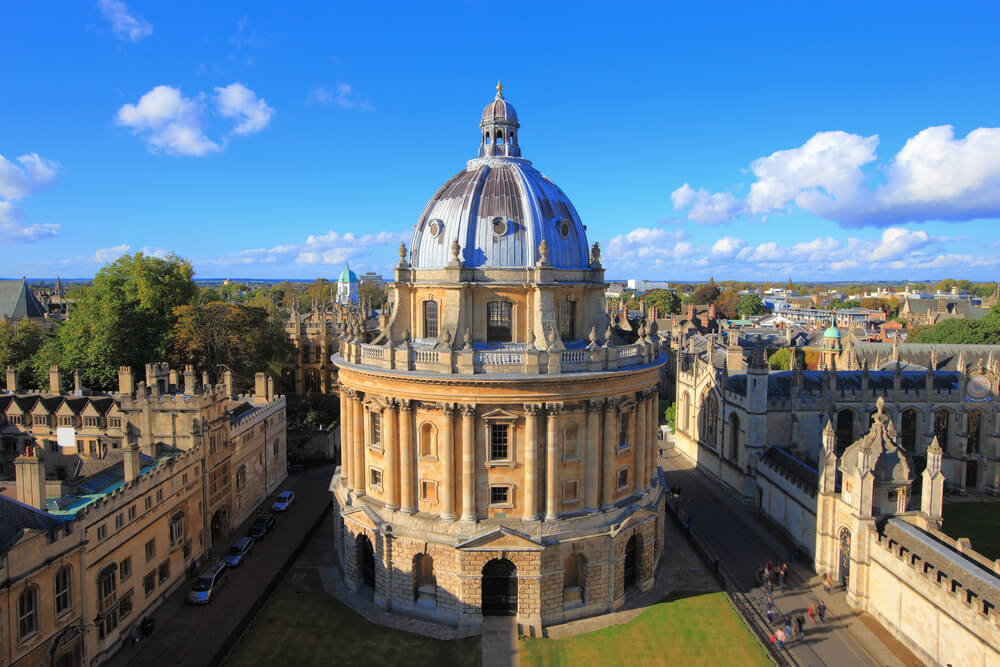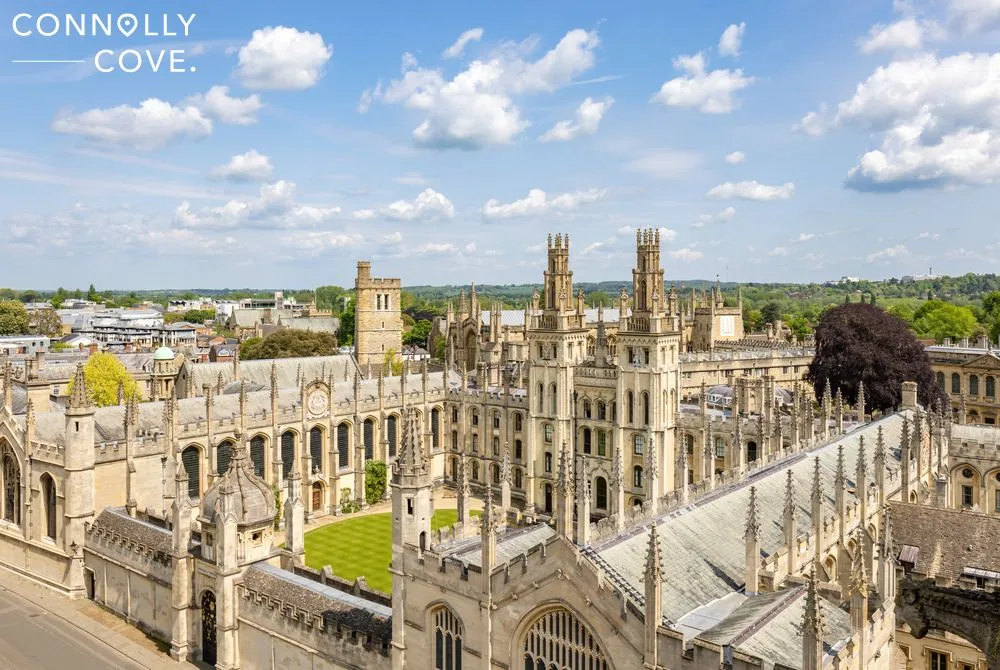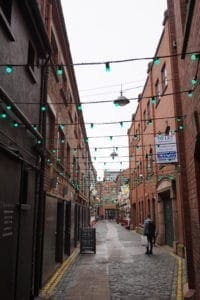Oxford, England: Where Academia Meets Afternoon Tea

Updated On: April 23, 2024 by Yasmin Elwan
Imagine cobbled streets whispering tales of scholars and literary giants, ancient colleges casting long shadows over hidden courtyards, and a river winding through the heart of a city steeped in history and innovation. This is Oxford, England, a place where the past whispers secrets to the present, and the future unfolds with every groundbreaking discovery.
From its humble beginnings as a 10th-century settlement to its current status as a global academic powerhouse, Oxford invites you on a journey through time, culture, and intellectual vibrancy. So, pack your curiosity, lace up your walking shoes, and get ready to be swept away by the magic of this timeless city.
Oxford Through the Ages: Wars and Revolutions
Nestled along the banks of the tranquil Thames River, Oxford, England, boasts a history as rich and diverse as the tapestries adorning its ancient halls. Stepping foot into this venerable city feels akin to embarking on a voyage through the annals of time, where each cobblestone pathway whispers tales of conquests, enlightenment, and scholarly pursuits.
Tracing its origins to the 10th century, Oxford’s storied past is a mosaic of conquests and cultural exchange. Originally a crossing point on the river, the city flourished under Saxon rule before becoming a thriving medieval market town. It wasn’t until the arrival of the Normans in 1066 that Oxford truly began to carve its place in the annals of history, as evidenced by the imposing towers of Oxford Castle, a testament to William the Conqueror’s iron-fisted grip on the region.
However, it was in the 12th century that Oxford’s destiny as a bastion of learning was truly sealed. With the founding of the University of Oxford in 1167, the city embarked on a journey towards academic excellence that would reverberate across the centuries. The university’s early days were marked by fervent debates and intellectual exchange, laying the groundwork for Oxford’s enduring reputation as a cradle of knowledge.
Medieval Prosperity
Throughout the medieval period, Oxford blossomed into a vibrant centre of scholarship and religious fervour. The city’s skyline soon became punctuated by the graceful spires of its colleges and churches, each bearing witness to the artistic and architectural marvels of the age. From the Gothic splendour of Christ Church Cathedral to the serene beauty of Magdalen College, Oxford’s architectural heritage is a testament to the ingenuity and craftsmanship of generations past.
As the centuries unfolded, Oxford continued to evolve, weathering political upheavals, scientific revolutions, and social change with stoic resilience. From the turbulent years of the English Civil War to the dawn of the Industrial Revolution, the city remained a beacon of stability and enlightenment in an ever-changing world.
Today, as visitors meander through Oxford’s labyrinthine streets, they are greeted by a tapestry of architectural styles spanning the ages. From the medieval charm of the Covered Market to the neoclassical grandeur of the Ashmolean Museum, each building tells a story, offering glimpses into Oxford’s illustrious past.
Academic Prestige: Oxford’s Enduring Legacy of Excellence

At the heart of Oxford’s global renown lies its unparalleled academic prestige, cultivated over centuries of rigorous scholarship and intellectual inquiry. Since its humble beginnings in the 12th century, the University of Oxford has stood as a beacon of learning, attracting the brightest minds from around the world and shaping the course of human knowledge in fields ranging from theology and philosophy to science and the arts.
Founded in 1167 by an ambitious group of scholars seeking refuge from the tumult of medieval Paris, the University of Oxford quickly established itself as a centre of intellectual excellence. Within decades, it had garnered the patronage of monarchs and nobles, who recognised the institution’s potential to cultivate a learned elite capable of guiding the affairs of state and church.
Over the ensuing centuries, the city’s reputation continued to soar, propelled by the groundbreaking research of its faculty and the insatiable curiosity of its students. From the pioneering work of Roger Bacon in the 13th century to the revolutionary discoveries of Sir Christopher Wren and Robert Hooke in the 17th century, Oxford’s scholars have left an indelible mark on the annals of history, reshaping our understanding of the natural world and the cosmos.
Central to Oxford’s academic prestige is its unique collegiate system, which fosters a sense of community and camaraderie among students while providing a rigorous intellectual environment conducive to learning and debate. With over 30 autonomous colleges and halls, each with its own distinct identity and traditions, Oxford offers students a wealth of opportunities for personal and intellectual growth, ensuring that they emerge not only as scholars but as well-rounded individuals equipped to tackle the challenges of an ever-changing world.
Diverse Research Endeavours
Moreover, Oxford’s commitment to academic excellence extends beyond the confines of its historic walls, encompassing a wide array of disciplines and research endeavours. Whether unravelling the mysteries of the human genome at the Wellcome Trust Centre for Human Genetics or exploring the frontiers of artificial intelligence at the Oxford Internet Institute, the university’s faculty and students are at the forefront of innovation and discovery, pushing the boundaries of knowledge and driving progress in fields as diverse as medicine, engineering, and the humanities.
Yet perhaps the true measure of the city’s academic prestige lies not in its illustrious past or cutting-edge research but in the countless lives it has touched and transformed over the centuries. From humble beginnings to global leaders, from pioneering scientists to visionary artists, Oxford’s alumni embody the university’s ethos of excellence and service, leaving an indelible imprint on the world and shaping the course of human history for generations to come.
Architectural Splendour
From the soaring spires of its iconic colleges to the tranquil cloisters of its ancient churches, Oxford’s architectural heritage is a testament to the skill and craftsmanship of generations past. The city’s medieval architecture, characterised by its Gothic arches, intricate stonework, and imposing towers, transports visitors back to a time of chivalry and romance, where knights and scholars alike roamed its hallowed halls.
Iconic Landmarks: A Glimpse into Oxford’s Architectural Pantheon
At the heart of Oxford’s architectural splendour lie its iconic landmarks, each bearing witness to the city’s storied past and enduring legacy. The Bodleian Library, with its grandiose facade and labyrinthine interiors, stands as a symbol of knowledge and enlightenment, housing centuries-old manuscripts and rare literary treasures within its hallowed walls. Nearby, the Radcliffe Camera enchants visitors with its neoclassical elegance, serving as a beacon of learning and culture in the heart of the city.
A hallmark of Oxford’s architectural landscape is its collegiate Gothic style, characterised by its ornate carvings, pointed arches, and vaulted ceilings. From the majestic quadrangles of Christ Church College to the intimate chapels of Magdalen and New College, each college boasts its own unique architectural features, reflecting the tastes and aspirations of its founders and benefactors.
Beyond the Colleges: Exploring Oxford’s Architectural Diversity
While the colleges may dominate Oxford’s skyline, the city’s architectural diversity extends far beyond its academic institutions. From the medieval charm of the Covered Market to the classical elegance of the Ashmolean Museum, Oxford’s streets are lined with a kaleidoscope of architectural styles, each offering a glimpse into the city’s rich and varied history.
Preservation and Conservation
As custodians of Oxford’s architectural legacy, city officials and conservationists have worked tirelessly to preserve and protect its historic buildings for future generations. Through careful restoration efforts and strict planning regulations, they ensure that the city’s architectural splendour continues to inspire and enchant visitors from around the world, serving as a reminder of the its enduring commitment to its past and its future.
Exploring Oxford’s Green Spaces and Scenic Beauty
As one meanders through the bustling streets of Oxford, a serene oasis awaits just beyond the city’s historic facades. Oxford’s green spaces and scenic beauty offer a welcome respite from the urban hustle, inviting visitors to explore tranquil parks, meandering rivers, and lush gardens that have captivated hearts for centuries.
Tracing its roots to the gentle flow of the Thames and Cherwell rivers, Oxford’s riverside walks are a testament to the city’s enduring connection with nature. From the picturesque banks of Christ Church Meadow to the verdant trails of Port Meadow, visitors can immerse themselves in the natural beauty of the city’s waterways, where swans glide gracefully across the surface and willows sway in the breeze.
Parks and Gardens: Sanctuaries of Serenity
University Parks, with its sprawling lawns and majestic trees, offers a tranquil escape from the bustle of city life, while the Botanic Garden delights the senses with its vibrant floral displays and exotic plant collections. Whether picnicking beneath the shade of an ancient oak or strolling through a fragrant rose garden, Oxford’s parks and gardens provide a sanctuary for reflection and relaxation.
For those with a penchant for arboreal splendour, the city boasts a wealth of historic arboretums and wooded sanctuaries waiting to be explored. The Harcourt Arboretum, nestled in the rolling hills of South Oxfordshire, enchants visitors with its diverse collection of trees and shrubs from around the world, while the ancient woodlands of Wytham Woods offer a glimpse into the untamed beauty of Oxfordshire’s countryside.
Throughout the year, those green spaces undergo a breathtaking transformation, each season painting a new masterpiece upon nature’s canvas. From the delicate blossoms of cherry trees in spring to the fiery hues of autumn leaves reflected in the tranquil waters of the Isis, Oxford’s seasonal spectacles offer a feast for the senses, reminding visitors of the timeless beauty that awaits just beyond the city’s ancient walls.
Sustainable Stewardship: Preserving Oxford’s Natural Heritage
As stewards of Oxford’s natural heritage, city officials and conservationists are committed to preserving and protecting its green spaces for future generations. Through sustainable practices and community engagement initiatives, they ensure that Oxford’s scenic beauty remains an integral part of the city’s cultural identity, inspiring awe and admiration in all who have the privilege to explore its verdant landscapes.
Events and Festivals
Each spring, the city becomes a literary mecca as writers, poets, and book lovers from around the world converge for the Oxford Literary Festival. Spanning ten days of literary delights, the festival features author readings, panel discussions, and book signings, providing a platform for literary luminaries to share their insights and inspiration with eager audiences.
As the first light of the dawn breaks over the dreaming spires of Oxford, residents and visitors alike gather in the city’s historic streets to celebrate May Morning, a time-honoured tradition dating back centuries. With the joyful strains of music filling the air and the scent of freshly baked pastries wafting from nearby cafes, May Morning is a festive celebration of springtime and renewal, marking the beginning of a new season with dancing, singing, and merrymaking.
For lovers of traditional music and folk culture, the Oxford Folk Festival offers a chance to immerse themselves in the rich musical heritage of the British Isles and beyond. From lively ceilidh dances to soul-stirring ballads, the festival showcases the talents of folk musicians from across the country, inviting audiences to join in the revelry and celebrate the timeless art of storytelling through song.
During the annual Oxford Open Doors event, the city throws open its doors to the public, offering rare access to some of its most cherished landmarks and hidden gems. From guided tours of historic colleges and churches to behind-the-scenes glimpses of scientific research facilities and cultural institutions, Oxford Open Doors provides a unique opportunity to explore the city’s rich architectural heritage and cultural legacy.
Getting Around the City
Oxford’s central railway station stands as a portal to the city’s wonders, offering direct connections to major destinations across the UK. Meanwhile, the city’s comprehensive bus network ensures convenient access to every corner, including key landmarks and attractions, making exploration effortless and efficient.
For those seeking a more leisurely pace, the city’s flat terrain and well-maintained cycle paths beckon. Rental shops abound, allowing visitors to hop on a bike and effortlessly traverse the city’s streets, discovering hidden gems and scenic vistas along the way.
And for the discerning wanderer, there’s no better way to absorb Oxford’s essence than on foot. From the charming alleys of the Covered Market to the tranquil courtyards of its colleges, walking offers an intimate glimpse into the city’s storied past and vibrant present.
Oxford, England, is an irresistible city that blends together hundreds of years of history, top-notch universities, stunning architecture, and peaceful nature, making it a truly charming and cultured place. Its ancient towers pierce the sky, while parks burst with greenery. From renowned universities to lively celebrations, the city of dreaming spires is packed with things to see and do. Whether you’re exploring its old streets, diving into its academic world, or just relaxing in its green havens, this historic city’s magic will surely leave you enchanted.






